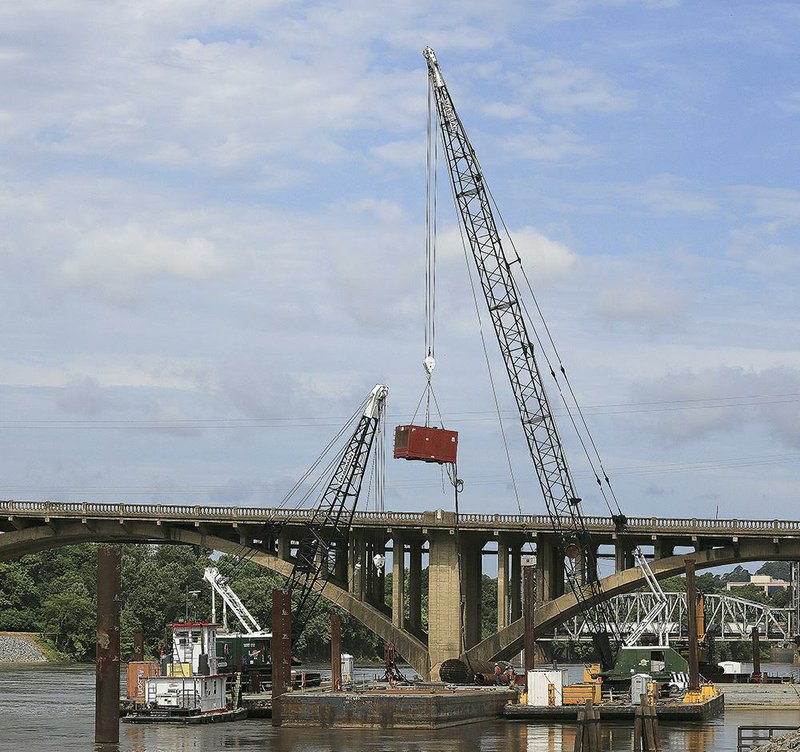The Arkansas River isn't the Mighty Mississippi, but it has proved to be a formidable force in the early going of the $98 million project to replace the Broadway Bridge linking Little Rock and North Little Rock.
Massman Construction Co. of Kansas City, Mo., the prime contractor on the Arkansas Highway and Transportation Department project, has lost 2½ months of work because of the river, swollen by an unusually heavy amount of spring rain, according to Dale Helmig, the project manager.
The river dislodged 200 tons of steel that workers were using to construct the 24 piers that will support the new bridge, he said.
But the setbacks aren't discouraging the 61-year-old Helmig, whose 33-year career with the company has taken him all over the South and Midwest overseeing bridge construction.
Projects have included the Stan Musial Veterans Memorial Bridge, a $667 million, 1,500-foot crossing over the Mississippi River at St. Louis. Dubbed the "Stan Span," the third-largest cable-stayed bridge in the United States opened to traffic in February 2014.
It's just a matter of time before the river goes down and work resumes, Helmig said, confident that his team will be able to close the crossing in May 2016, as scheduled. The crossing will be closed for six months while workers remove the old bridge and put in the new one.
The company will be docked $80,000 for every day that the crossing is closed to traffic past the 180-day limit. Conversely, if the bridge is finished before that 180 days, the company stands to gain $80,000 for every day it was early.
"As soon as that river drops about 4 feet, you'll see a lot of activity," Helmig said.
According to the National Weather Service's office in North Little Rock, that may be a while. The river has been dropping, but it is expected to rise again this week because of the continued release of water from lakes upstream in Fort Smith and Oklahoma, meteorologist Julie Lesko said.
Massman Construction workers were able to fill only one of the 24 drilled shafts that will be used for the bridge support piers before the rising water stopped their work.
That shaft on the north bank of the Arkansas River is 88 feet deep and 9 feet in diameter. It took 200 yards of concrete, or about 25 truckloads, to fill it, Helmig said.
To properly align the shafts, a steel template -- that is 15 feet wide and 70 feet long and weighs 30 tons -- is used. It aligns four shafts at a time.
Before the river rose earlier this year, the template was set on four pipe pilings, each 64 feet long and 36 inches in diameter and weighing 15 tons.
The template was bolted to the concrete piers of the existing bridge with four steel pipes. But the current ripped the piping from the piers and sent the template and other steel to the bottom of the river. Included in the dislodged steel were four shaft casings weighing 30 tons.
"Maybe the old concrete wasn't strong enough to hold them," Helmig said, adding that the steel will eventually be recovered and reused once the river level drops.
For now, about 20 workers are on-site. As the work ramps up, Helmig said, the crew will grow to 80, working in two shifts around the clock at times.
Much of the early work was getting barges, cranes and drilling equipment in place, and setting up offices near the base of the existing bridge on the north side of the river.
The ramps leading to and from LaHarpe Boulevard on the Little Rock side have been removed, and workers are putting up the new LaHarpe ramp and the shared-use ramps on both sides of the river that will connect to the Arkansas River Trail. The work has required detours on the River Trail on both sides of the river.
Massman Construction crews also have dug into the levee on the north bank to allow concrete trucks to back onto the barges to unload. A temporary walkway from land to the barges also is being constructed to make it safer for workers to get on and off the barges.
Much of the early work is drilling into the riverbed and is little noticed by passers-by, but that will change this fall when eight Massman Construction barges will line up along the north riverbank. The barges will be used for assembling the twin arches for the new bridge. The arches are being manufactured elsewhere and will be shipped to the site.
Once the arches are put together, the barges will be used to float the arches -- each 450 feet long and weighing 2,000 tons -- into place above the new piers and caps. Then the barges will be flooded with water and the arches lowered into place, Helmig said.
The current bridge opened to traffic in 1923 to great fanfare. Civic leaders boasted that it would last 1,000 years.
But 92 years later, all three of its components -- superstructure, substructure and deck -- are rated structurally deficient. While state highway officials insist that it's safe for traffic for now, the bridge has been increasingly costly to maintain, making replacing it a more cost-effective option.
Work to replace the bridge, which is on U.S. 70, also called Broadway, began in 2011.
As part of the project, Pulaski County has committed $20 million to incorporate two basket-handle arches into the design, instead of just one arch, as the Highway Department had proposed. That money will be paid over several years.
Local officials on both sides of the river have been "good to work with," said Helmig, who started work in January.
"When you go into a new place, you don't know who to call to hook up the water, the electrical," he said. "They've bent over backwards."
Metro on 07/05/2015
